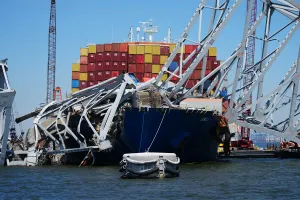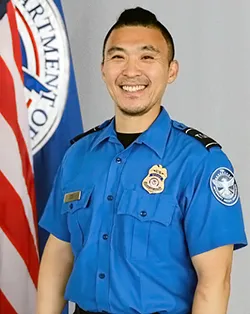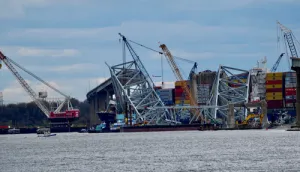 Container ship, Dali, after the crash (File photo)
Container ship, Dali, after the crash (File photo)
In the early morning hours of March 26, the Singaporean-registered cargo ship, Dali, lost power and crashed into Baltimore’s Francis Scott Key Bridge, forcing a section of the bridge to collapse, and TSA played a key role in the National Transportation Safety Board’s (NTSB) investigation.
The ship was loaded with 4,700 cargo containers and 1.5 million gallons of fuel and lubricant oil, and the bridge’s collapse essentially closed the Port of Baltimore to all shipping traffic and created massive headaches for motorists who routinely used the bridge.
The NTSB began its investigation with the help of the local FBI office. An electrical switching panel on the ship, manufactured in South Korea, became a focus of the probe. The NTSB called in six engineers from South Korea, but there were two initial problems. They needed an interpreter and help with getting the engineers to Baltimore quickly to inspect the panel.
Enter the FBI’s partnership with TSA.
“Our Baltimore/Washington International Thurgood Marshall Airport (BWI) FBI liaisons, who we work with daily and who were working the bridge collapse and recovery efforts, reached out to us on behalf of the NTSB,” said BWI Federal Security Director (FSD) Chris Murgia.
The NTSB asked if anyone from TSA spoke fluent Korean to help in the inspection of the vessel.
“I asked our Assistant Federal Security Director (AFSD) for Screening, Cynthia Rahmani, if we had anyone within our screening ranks who spoke fluent Korean,” recalled Murgia. “It just so happened that TSA Officer Sean Shin earned a luncheon with our AFSD by winning one of our local screening contests. During that luncheon, Rahmani learned from Sean that he lived most of his life in Korea prior to coming to the United States.”
The timing of that lunch was fortuitous. After Rahmani identified Shin to help with the language translation at the collapsed bridge site, TSA’s International Operations team worked closely with the Singaporean Ministry of Transport and the local U.S. Customs and Border Protection attaché to expedite the engineer’s travel paperwork for their arrival.
Over the course of two days, Shin worked with two NTSB investigators, the six Korean Hyundai engineers, an interpreter hired by Hyundai, three lawyers for the motor company and a Maryland State Police officer, who was also fluent in Korean.
“I studied engineering terms after I received assignments from TSA and NTSB,” said Shin. “There was no language barrier during conversations with the engineers.
“The NTSB requested I wear comfortable clothes, such as tactical pants and a shirt as we had to climb up a ladder on the side of the ship; there was no door,” he said.
The NTSB asked the engineers numerous technical questions, and Shin translated, going over the data until everyone understood.
“On my own, I asked around to the Korean engineers what they thought about the event and shared that information with the NTSB. If I have a chance to help another agency or TSA, I am willing and able,” added Shin.
“This was the epitome of collaboration and partnerships,” added Murgia. “Having good partnerships and knowing your teams and their assets are invaluable when their skills are needed. Having the great working relationships and the ease of communications between our stakeholders and external partners proved to be the success for this request!
“Sean was eager to assist when we notified him of the situation. He worked long hours and committed himself to the NTSB the entire time while he was onboard the ship. His willingness to go ‘above and beyond’ his scope of duties to support another federal agency was paramount in obtaining the desired outcomes of the mission of the NTSB. Sean’s efforts, professionalism and language skills exhibited during the inspection of the vessel proved to be invaluable to the investigation. We are proud of Officer Shin and his contributions, not only as an officer to TSA Maryland, but to the entire agency and for representing us well!”
By Michele Robbins, Strategic Communications and Public Affairs


